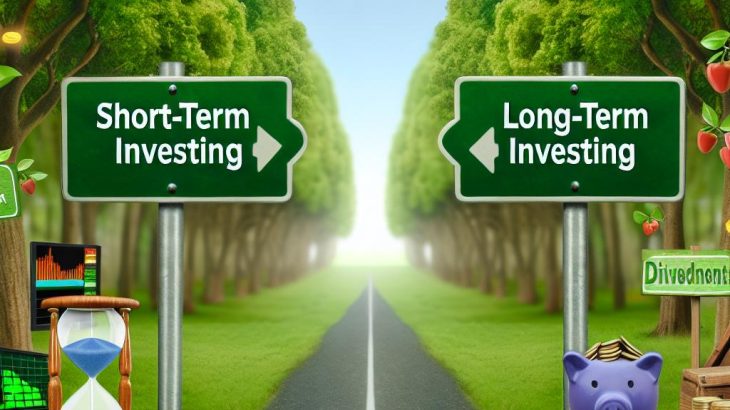Understanding Short-Term and Long-Term Investing
As you consider how to grow your wealth, you may find yourself choosing between short-term and long-term investing. Each strategy caters to different financial goals, risk tolerances, and timelines. Understanding the nuances between these investment horizons is crucial for making an informed decision.
Short-Term Investing
Short-term investing typically involves a time horizon of less than three years. This approach focuses on earning quick returns and often involves buying and selling assets within this shorter timeframe. Let’s further explore the characteristics and implications associated with short-term investing.
Pros of Short-Term Investing
- Liquidity: Short-term investments are often more liquid, allowing investors to quickly access cash when needed. This attribute makes short-term strategies appealing for those who require funds without considerable waiting periods.
- Flexibility: The ability to rapidly change investment strategies based on market trends can be appealing. Investors can take advantage of fluctuations and emerging opportunities through dynamic management of their portfolios.
Cons of Short-Term Investing
- Volatility: Markets can be unpredictable in the short term, leading to potential losses. This behavior means a higher level of market risk, with prices swinging widely over short periods due to economic data, geopolitical events, and investor sentiment.
- Higher Costs: Frequent trading can incur significant transaction fees and possibly higher taxes on capital gains. The cost of buying and selling assets quickly can reduce overall profit margins, making this an expensive endeavor unless carefully managed.
Long-Term Investing
Long-term investing involves holding assets over several years, often for a period extending beyond ten years. This strategy is designed to build wealth gradually and benefits from the compounding effect. Let’s delve into the characteristics that define long-term investing.
Pros of Long-Term Investing
- Compounding: Earnings reinvested over a long period can result in exponential growth. The power of compounding allows small gains to accumulate substantially over years, turning modest investments into significant wealth.
- Lower Taxes: Long-term capital gains are typically taxed at a lower rate than short-term gains. This aspect makes long-term investing tax-efficient, allowing more of the investment return to remain within your portfolio.
- Stability: Historically, markets tend to rise over the long run, bringing stability to investments. While short-term fluctuations occur, the general upward trajectory over decades benefits those patient enough to hold through various market cycles.
Cons of Long-Term Investing
- Less Liquidity: Access to funds may be limited, as investments are tied up for extended periods. Investors may not be able to respond quickly to emergencies or opportunities that require rapid capital access.
- Inflexibility: Long-term investors may miss opportunities to capitalize on short-term market movements. The commitment to a prolonged investment horizon might mean sitting through dips in the market or passing on quickly materializing opportunities.
Factors to Consider
When deciding between short-term and long-term investing, it’s essential to assess your personal circumstances, financial goals, and risk tolerance. Let’s examine some critical factors:
Financial Goals
- Short-term goals, such as a wedding or a down payment, might benefit from short-term investments. The need for funds at a specific time makes liquidity and reduced volatility top priorities.
- Long-term objectives, like retirement, are better aligned with long-term investments. The focus here is on growth and the accumulation of wealth over decades to meet future financial needs.
Risk Tolerance
Assess how much risk you are willing to take. Short-term investments often involve higher risks due to volatility, whereas long-term investments are generally less risky. An honest self-assessment is key to choosing an investment strategy in harmony with your comfort level with market fluctuations.
Market Knowledge
Engaging in short-term investing may require more frequent analysis and understanding of market trends. Actively managing a short-term investment portfolio demands staying informed about economic conditions, technical indicators, and industry developments. In contrast, long-term investors can often adopt a more passive approach, relying on fundamental analysis and broader economic principles rather than daily market changes.
Diversification
Diversification is crucial regardless of the investment horizon. A well-diversified portfolio can protect against risk and enhance returns. For short-term investors, diversification can mitigate sudden market swings, while long-term investors benefit from spreading exposure across various asset classes to capture growth potential.
Time Commitment
The time you are willing and able to commit to managing your investments is an important consideration. Short-term investing often requires active management, continuous monitoring, and regular decision-making. Long-term investing, conversely, can be less demanding, with periodic reviews and adjustments as opposed to constant involvement.
Conclusion
Choosing between short-term and long-term investing ultimately depends on your individual goals, timelines, and financial situation. Both strategies have their merits and drawbacks, and some investors may find a blended approach that includes elements of both types of investing most suitable. By understanding the fundamental differences and nuances between these two investment strategies, you can tailor your approach to fit your financial needs and risk appetite. At times, consulting a financial advisor for tailored advice might also enhance your strategic planning. For those keen to deepen their understanding, reputable resources such as the Investopedia or the SEC’s Guide to Investment can offer further insights into crafting a robust investment strategy.
This article was last updated on: March 17, 2025
